Multimodal Emotion Recognition
Multimodal emotion recognition is the process of recognizing emotions from multiple modalities, such as speech, text, and facial expressions.
Papers and Code
Enhancing Multimodal Emotion Recognition through Multi-Granularity Cross-Modal Alignment
Dec 30, 2024Multimodal emotion recognition (MER), leveraging speech and text, has emerged as a pivotal domain within human-computer interaction, demanding sophisticated methods for effective multimodal integration. The challenge of aligning features across these modalities is significant, with most existing approaches adopting a singular alignment strategy. Such a narrow focus not only limits model performance but also fails to address the complexity and ambiguity inherent in emotional expressions. In response, this paper introduces a Multi-Granularity Cross-Modal Alignment (MGCMA) framework, distinguished by its comprehensive approach encompassing distribution-based, instance-based, and token-based alignment modules. This framework enables a multi-level perception of emotional information across modalities. Our experiments on IEMOCAP demonstrate that our proposed method outperforms current state-of-the-art techniques.
A Multimodal Emotion Recognition System: Integrating Facial Expressions, Body Movement, Speech, and Spoken Language
Dec 23, 2024Traditional psychological evaluations rely heavily on human observation and interpretation, which are prone to subjectivity, bias, fatigue, and inconsistency. To address these limitations, this work presents a multimodal emotion recognition system that provides a standardised, objective, and data-driven tool to support evaluators, such as psychologists, psychiatrists, and clinicians. The system integrates recognition of facial expressions, speech, spoken language, and body movement analysis to capture subtle emotional cues that are often overlooked in human evaluations. By combining these modalities, the system provides more robust and comprehensive emotional state assessment, reducing the risk of mis- and overdiagnosis. Preliminary testing in a simulated real-world condition demonstrates the system's potential to provide reliable emotional insights to improve the diagnostic accuracy. This work highlights the promise of automated multimodal analysis as a valuable complement to traditional psychological evaluation practices, with applications in clinical and therapeutic settings.
HumanVBench: Exploring Human-Centric Video Understanding Capabilities of MLLMs with Synthetic Benchmark Data
Dec 23, 2024In the domain of Multimodal Large Language Models (MLLMs), achieving human-centric video understanding remains a formidable challenge. Existing benchmarks primarily emphasize object and action recognition, often neglecting the intricate nuances of human emotions, behaviors, and speech visual alignment within video content. We present HumanVBench, an innovative benchmark meticulously crafted to bridge these gaps in the evaluation of video MLLMs. HumanVBench comprises 17 carefully designed tasks that explore two primary dimensions: inner emotion and outer manifestations, spanning static and dynamic, basic and complex, as well as single-modal and cross-modal aspects. With two advanced automated pipelines for video annotation and distractor-included QA generation, HumanVBench utilizes diverse state-of-the-art (SOTA) techniques to streamline benchmark data synthesis and quality assessment, minimizing human annotation dependency tailored to human-centric multimodal attributes. A comprehensive evaluation across 16 SOTA video MLLMs reveals notable limitations in current performance, especially in cross-modal and temporal alignment, underscoring the necessity for further refinement toward achieving more human-like understanding. HumanVBench is open-sourced to facilitate future advancements and real-world applications in video MLLMs.
Effective Context Modeling Framework for Emotion Recognition in Conversations
Dec 21, 2024Emotion Recognition in Conversations (ERC) facilitates a deeper understanding of the emotions conveyed by speakers in each utterance within a conversation. Recently, Graph Neural Networks (GNNs) have demonstrated their strengths in capturing data relationships, particularly in contextual information modeling and multimodal fusion. However, existing methods often struggle to fully capture the complex interactions between multiple modalities and conversational context, limiting their expressiveness. To overcome these limitations, we propose ConxGNN, a novel GNN-based framework designed to capture contextual information in conversations. ConxGNN features two key parallel modules: a multi-scale heterogeneous graph that captures the diverse effects of utterances on emotional changes, and a hypergraph that models the multivariate relationships among modalities and utterances. The outputs from these modules are integrated into a fusion layer, where a cross-modal attention mechanism is applied to produce a contextually enriched representation. Additionally, ConxGNN tackles the challenge of recognizing minority or semantically similar emotion classes by incorporating a re-weighting scheme into the loss functions. Experimental results on the IEMOCAP and MELD benchmark datasets demonstrate the effectiveness of our method, achieving state-of-the-art performance compared to previous baselines.
Movie2Story: A framework for understanding videos and telling stories in the form of novel text
Dec 19, 2024Multimodal video-to-text models have made considerable progress, primarily in generating brief descriptions of video content. However, there is still a deficiency in generating rich long-form text descriptions that integrate both video and audio. In this paper, we introduce a framework called M2S, designed to generate novel-length text by combining audio, video, and character recognition. M2S includes modules for video long-form text description and comprehension, audio-based analysis of emotion, speech rate, and character alignment, and visual-based character recognition alignment. By integrating multimodal information using the large language model GPT4o, M2S stands out in the field of multimodal text generation. We demonstrate the effectiveness and accuracy of M2S through comparative experiments and human evaluation. Additionally, the model framework has good scalability and significant potential for future research.
Unimodal and Multimodal Static Facial Expression Recognition for Virtual Reality Users with EmoHeVRDB
Dec 15, 2024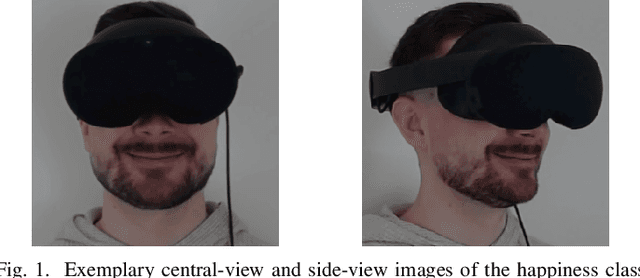
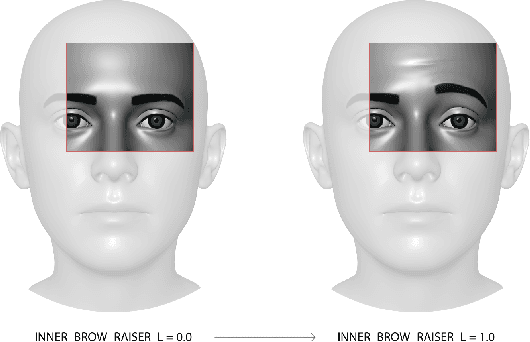
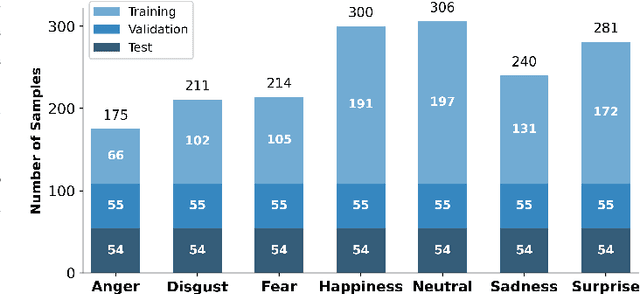
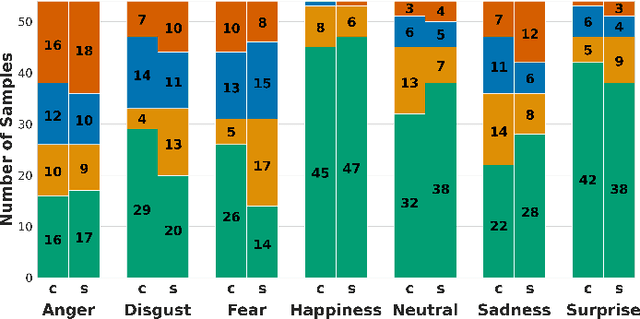
In this study, we explored the potential of utilizing Facial Expression Activations (FEAs) captured via the Meta Quest Pro Virtual Reality (VR) headset for Facial Expression Recognition (FER) in VR settings. Leveraging the EmojiHeroVR Database (EmoHeVRDB), we compared several unimodal approaches and achieved up to 73.02% accuracy for the static FER task with seven emotion categories. Furthermore, we integrated FEA and image data in multimodal approaches, observing significant improvements in recognition accuracy. An intermediate fusion approach achieved the highest accuracy of 80.42%, significantly surpassing the baseline evaluation result of 69.84% reported for EmoHeVRDB's image data. Our study is the first to utilize EmoHeVRDB's unique FEA data for unimodal and multimodal static FER, establishing new benchmarks for FER in VR settings. Our findings highlight the potential of fusing complementary modalities to enhance FER accuracy in VR settings, where conventional image-based methods are severely limited by the occlusion caused by Head-Mounted Displays (HMDs).
M2SE: A Multistage Multitask Instruction Tuning Strategy for Unified Sentiment and Emotion Analysis
Dec 11, 2024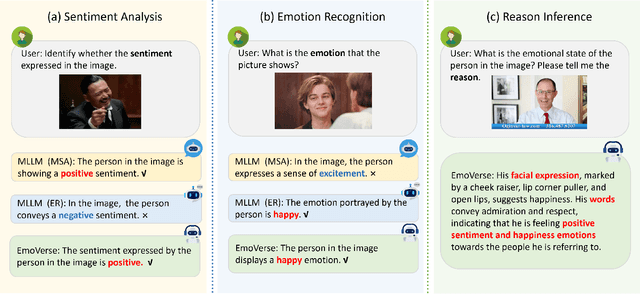
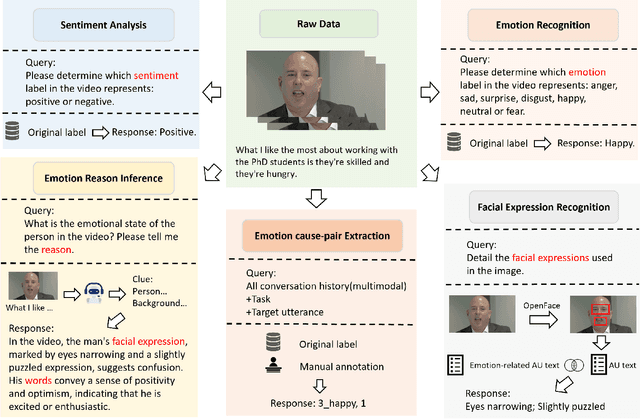


Sentiment analysis and emotion recognition are crucial for applications such as human-computer interaction and depression detection. Traditional unimodal methods often fail to capture the complexity of emotional expressions due to conflicting signals from different modalities. Current Multimodal Large Language Models (MLLMs) also face challenges in detecting subtle facial expressions and addressing a wide range of emotion-related tasks. To tackle these issues, we propose M2SE, a Multistage Multitask Sentiment and Emotion Instruction Tuning Strategy for general-purpose MLLMs. It employs a combined approach to train models on tasks such as multimodal sentiment analysis, emotion recognition, facial expression recognition, emotion reason inference, and emotion cause-pair extraction. We also introduce the Emotion Multitask dataset (EMT), a custom dataset that supports these five tasks. Our model, Emotion Universe (EmoVerse), is built on a basic MLLM framework without modifications, yet it achieves substantial improvements across these tasks when trained with the M2SE strategy. Extensive experiments demonstrate that EmoVerse outperforms existing methods, achieving state-of-the-art results in sentiment and emotion tasks. These results highlight the effectiveness of M2SE in enhancing multimodal emotion perception. The dataset and code are available at https://github.com/xiaoyaoxinyi/M2SE.
WavFusion: Towards wav2vec 2.0 Multimodal Speech Emotion Recognition
Dec 07, 2024Speech emotion recognition (SER) remains a challenging yet crucial task due to the inherent complexity and diversity of human emotions. To address this problem, researchers attempt to fuse information from other modalities via multimodal learning. However, existing multimodal fusion techniques often overlook the intricacies of cross-modal interactions, resulting in suboptimal feature representations. In this paper, we propose WavFusion, a multimodal speech emotion recognition framework that addresses critical research problems in effective multimodal fusion, heterogeneity among modalities, and discriminative representation learning. By leveraging a gated cross-modal attention mechanism and multimodal homogeneous feature discrepancy learning, WavFusion demonstrates improved performance over existing state-of-the-art methods on benchmark datasets. Our work highlights the importance of capturing nuanced cross-modal interactions and learning discriminative representations for accurate multimodal SER. Experimental results on two benchmark datasets (IEMOCAP and MELD) demonstrate that WavFusion succeeds over the state-of-the-art strategies on emotion recognition.
Dynamic Graph Neural Ordinary Differential Equation Network for Multi-modal Emotion Recognition in Conversation
Dec 04, 2024



Multimodal emotion recognition in conversation (MERC) refers to identifying and classifying human emotional states by combining data from multiple different modalities (e.g., audio, images, text, video, etc.). Most existing multimodal emotion recognition methods use GCN to improve performance, but existing GCN methods are prone to overfitting and cannot capture the temporal dependency of the speaker's emotions. To address the above problems, we propose a Dynamic Graph Neural Ordinary Differential Equation Network (DGODE) for MERC, which combines the dynamic changes of emotions to capture the temporal dependency of speakers' emotions, and effectively alleviates the overfitting problem of GCNs. Technically, the key idea of DGODE is to utilize an adaptive mixhop mechanism to improve the generalization ability of GCNs and use the graph ODE evolution network to characterize the continuous dynamics of node representations over time and capture temporal dependencies. Extensive experiments on two publicly available multimodal emotion recognition datasets demonstrate that the proposed DGODE model has superior performance compared to various baselines. Furthermore, the proposed DGODE can also alleviate the over-smoothing problem, thereby enabling the construction of a deep GCN network.
Multimodal Sentiment Analysis based on Video and Audio Inputs
Dec 12, 2024Despite the abundance of current researches working on the sentiment analysis from videos and audios, finding the best model that gives the highest accuracy rate is still considered a challenge for researchers in this field. The main objective of this paper is to prove the usability of emotion recognition models that take video and audio inputs. The datasets used to train the models are the CREMA-D dataset for audio and the RAVDESS dataset for video. The fine-tuned models that been used are: Facebook/wav2vec2-large for audio and the Google/vivit-b-16x2-kinetics400 for video. The avarage of the probabilities for each emotion generated by the two previous models is utilized in the decision making framework. After disparity in the results, if one of the models gets much higher accuracy, another test framework is created. The methods used are the Weighted Average method, the Confidence Level Threshold method, the Dynamic Weighting Based on Confidence method, and the Rule-Based Logic method. This limited approach gives encouraging results that make future research into these methods viable.
* Presented as a full paper in the 15th International Conference on Emerging Ubiquitous Systems and Pervasive Networks (EUSPN 2024) October 28-30, 2024, Leuven, Belgium
 Add to Chrome
Add to Chrome Add to Firefox
Add to Firefox Add to Edge
Add to Edge